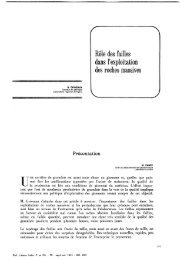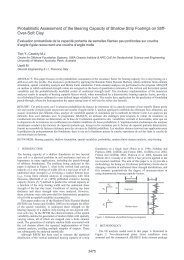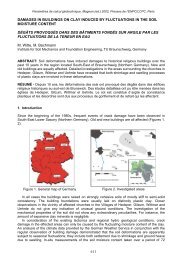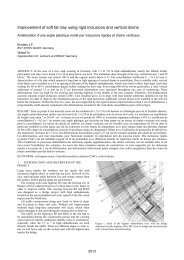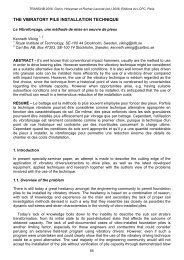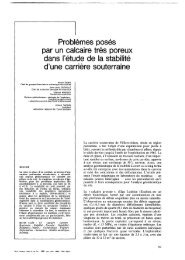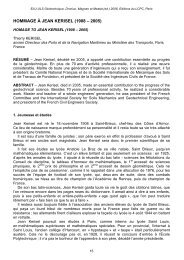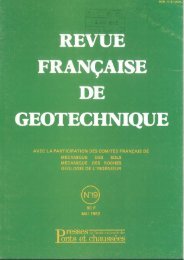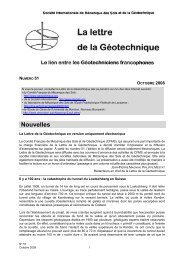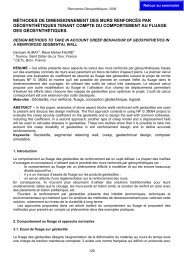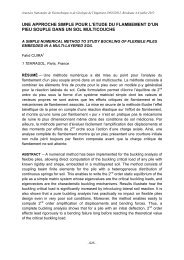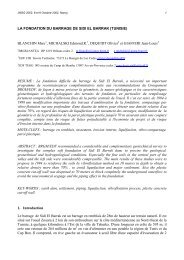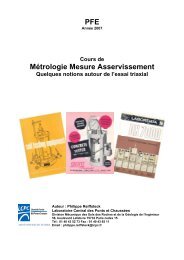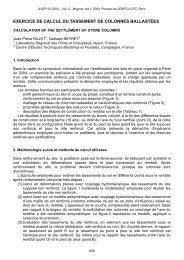La Craie
La Craie
La Craie
You also want an ePaper? Increase the reach of your titles
YUMPU automatically turns print PDFs into web optimized ePapers that Google loves.
The stability of very high chalk embankments<br />
A. DE RAGUENEL<br />
Observations and studies made on the Val-Guyon embankment on the A 13 autoroute have provided<br />
an explanation of the cause of the settlements and cracks observed.<br />
These disturbances cannot be explained by classical theories. It is shown that the settlements of<br />
the bed of the embankment are attributable to a densification of the latter resulting from a disintegration<br />
of the low-density chalk blocks in the course of time. This densification may lead to pressure<br />
being exerted on the pore water and an increase in the Poisson's ratio of the chalky mixture. This<br />
variation may in turn entail, as shown by a study of stresses using the method of finite elements,<br />
the development of tensile stresses at the head of the embankment which would explain the longitudinal<br />
cracks observed.<br />
These calculations made it possible to define the influence of the mechanical characteristics of the<br />
chalk, the height of the embankment, and its gradient, on the development of such cracks. This<br />
led to the possibility of laying down recommendations for the use of soft chalk in constructing<br />
embankments of various geometries.<br />
<strong>La</strong> craie, Bull. Liaison <strong>La</strong>bo. P. et Ch., special V, oct. 1973, p. 57.<br />
Problems of earthworks in chalk<br />
J. PUIG<br />
The authors give the results of research conducted on the problems of earthworks in chalk, and the<br />
practical conclusions that may be drawn from them.<br />
Conventional geotechnical tests (particle size, Atterberg limits, water content, Proctor test) are<br />
unsuitable for identifying chalk, which is essentially an evolutive material, and consequently they<br />
cannot be used for predicting its behaviour.<br />
The percentage of paste or fineshas a predominant influence on working conditions. This percentage<br />
is essentially dependent on the nature of the « rock chalk », which may be more or less easy to break<br />
up, and also on the nature of the handling to which it is subjected.<br />
Research has led to the development of empirical tests enabling both these factors to be determined<br />
simultaneously : the vibrocrushing test and the repeated compaction test.<br />
On-site observations of the construction of chalk embankments and their stability in the longer<br />
term have made it possible to lay down recommendations concerning the geotechnical study of<br />
chalky materials and their conditions of use in the light of their nature and of the geometry of the<br />
structure.<br />
<strong>La</strong> craie, Bull. Liaison <strong>La</strong>bo. P. et Ch., special V, oct. 1973, p. 81.<br />
The study, by vibration grinding, of the aptitude of chalks for compacting<br />
R. STRUILLOU<br />
The use of vibration grinding is envisaged for the purpose of predicting in the laboratory the difficulties<br />
of compacting chalks on working sites. Crushed dry samples in the form of 5/20 aggregates<br />
are ground for 30 s at various water contents. It is observed that for most chalks the quantity of<br />
elements below 1,25 mm which are formed varies linearly with the water content. Every chalk can<br />
therefore be characterized by a line of wear which gives its sensitivity to fragmentation.<br />
Furthermore, the fines of a given chalk are characterized by their liquid limit WL with effect from<br />
products below 400 microns formed by vibration grinding of the chalk in an aqueous medium under<br />
constant conditions (so as to allow for the sensitivity of the Atterberg limits of many chalks to operating<br />
conditions).<br />
By combining the characteristics of wear, natural water content w„, liquid limit WL of finesproduced<br />
by vibration grinding, and empirical coefficients whose purpose is to allow for various conditions<br />
on site, it is possible to determine the critical water content w c<br />
beyond which serious difficulties may<br />
be encountered during compacting.<br />
<strong>La</strong> craie, Bull. Liaison <strong>La</strong>bo. P. et Ch., special V, oct. 1973, p. 99.



